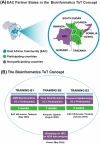A capacity strengthening model toward self-reliant and sustainable one-health workforce in six East African Community Partner States
- PMID: 40777654
- PMCID: PMC12328454
- DOI: 10.3389/fpubh.2025.1636817
A capacity strengthening model toward self-reliant and sustainable one-health workforce in six East African Community Partner States
Abstract
The burden of infectious diseases and antimicrobial resistance (AMR) in Africa highlights the critical need for strengthened genomic surveillance capacities that are embedded within the national public health framework. In the East African Community (EAC), this challenge is compounded by limited infrastructure and insufficient workforce capacity in bioinformatics and genomics, particularly within National Public Health Laboratories (NPHLs). This paper describes the implementation of a regional capacity-building initiative based on a multi-phase Training-of-Trainers (ToT) model across six EAC Partner States. Anchored in a One Health framework, the initiative focused on equipping public health professionals within NPHLs with practical skills in pathogen genomics, AMR analysis, and bioinformatics workflows, while also supporting the institutionalization of standardized procedures and tools. Through modular training, in-country cascade sessions, and structured mentorship, the program enabled integration of genomic approaches into public health surveillance activities. Despite infrastructural and operational constraints, the initiative supported measurable gains in applied proficiency, routine use of genomics tools in surveillance tasks, and regional coordination on pathogen data analysis. This case study outlines the program's design, implementation, and observed outcomes, and offers a transferable framework for workforce and systems development in low-resource settings. This experience contributes to ongoing global discussions on equitable genomic surveillance and preparedness by demonstrating how structured, context-specific training can support sustainable adoption of genomics within national public health institutions.
Keywords: East African Community (EAC); National Public Health Laboratories (NPHLs); One Health; Training-of-Trainers (ToT); antimicrobial resistance (AMR); bioinformatics capacity building; genomic surveillance.
Copyright © 2025 Nguinkal, Gehre, Lagu, Achol, Nzeyimana, Kiiru, Nyandwi, Dumo, Moremi, Nabadda, Mukagatare, Molina, May and Affara.
Conflict of interest statement
The authors declare that the research was conducted in the absence of any commercial or financial relationships that could be construed as a potential conflict of interest.
Figures


Similar articles
-
Accreditation through the eyes of nurse managers: an infinite staircase or a phenomenon that evaporates like water.J Health Organ Manag. 2025 Jun 30. doi: 10.1108/JHOM-01-2025-0029. Online ahead of print. J Health Organ Manag. 2025. PMID: 40574247
-
Prescription of Controlled Substances: Benefits and Risks.2025 Jul 6. In: StatPearls [Internet]. Treasure Island (FL): StatPearls Publishing; 2025 Jan–. 2025 Jul 6. In: StatPearls [Internet]. Treasure Island (FL): StatPearls Publishing; 2025 Jan–. PMID: 30726003 Free Books & Documents.
-
Health professionals' experience of teamwork education in acute hospital settings: a systematic review of qualitative literature.JBI Database System Rev Implement Rep. 2016 Apr;14(4):96-137. doi: 10.11124/JBISRIR-2016-1843. JBI Database System Rev Implement Rep. 2016. PMID: 27532314
-
Tuberculosis Prevention, Control, and Elimination.2025 Jul 6. In: StatPearls [Internet]. Treasure Island (FL): StatPearls Publishing; 2025 Jan–. 2025 Jul 6. In: StatPearls [Internet]. Treasure Island (FL): StatPearls Publishing; 2025 Jan–. PMID: 30020618 Free Books & Documents.
-
Progress on the Global Research Agenda for Antimicrobial Resistance in Human Health in Pakistan: Findings and Implications.Infect Drug Resist. 2025 Jul 29;18:3795-3828. doi: 10.2147/IDR.S531874. eCollection 2025. Infect Drug Resist. 2025. PMID: 40761881 Free PMC article. Review.
References
-
- Ngom R, Gueye AS, Lassieur S, Oloo S, Shahid R, Mize V, et al. Five decades of infectious diseases outbreaks in the African region (1970–2018) a geographic snapshot. Soc Sci Human Open. (2023) 8:100625. 10.1016/j.ssaho.2023.100625 - DOI
-
- World Health Organization . Global Genomic Surveillance Strategy for Pathogens with Pandemic and Epidemic Potential, 2022–2032. Geneva: World Health Organization; (2022). Available online at: https://www.who.int/publications/i/item/9789240046979 (Accessed July 30, 2024). - PMC - PubMed
MeSH terms
LinkOut - more resources
Full Text Sources

